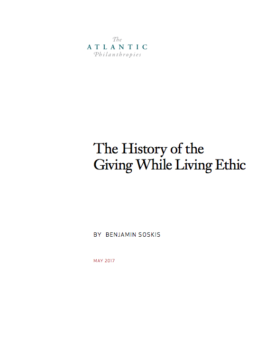The History of the Giving While Living Ethic
Resource type: Research Report
Benjamin Soskis |
When Chuck Feeney decided over three decades ago to transfer virtually all his personal fortune to what would become The Atlantic Philanthropies, he said he was doing it out of a belief in Giving While Living – the idea that individuals of great means should use their money to help people during their lifetimes.
In “The History of the Giving While Living Ethic,” historian Benjamin Soskis writes that Giving While Living is a more complex phenomenon than that three-word slogan would suggest. Soskis breaks it down into three intertwined imperatives, exploring the distinct historical development of each, while also highlighting the tensions that have emerged between them and between limited life philanthropy.
- The first imperative makes a transactional and temporal demand on the donor, requiring him or her to commit money to charitable causes while still alive.
- The second requires the active engagement of the donor in administering or overseeing the gift.
- And the third imperative is promotional and educative—the giving must be done publicly, with an audience of other givers in mind.
Soskis shows how each of these three strands of Giving While Living flows through long-running debates about the responsibilities of wealth and through the story of Feeney’s and The Atlantic Philanthropies’ commitment to entrepreneurial giving.
Atlantic commissioned “The History of the Giving While Living Ethic.”
